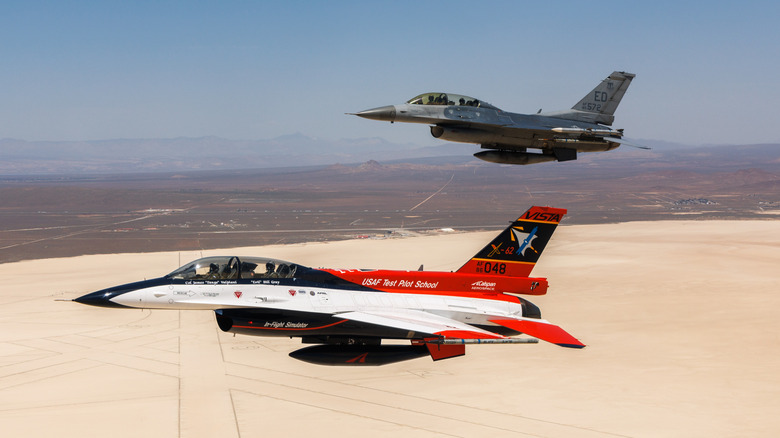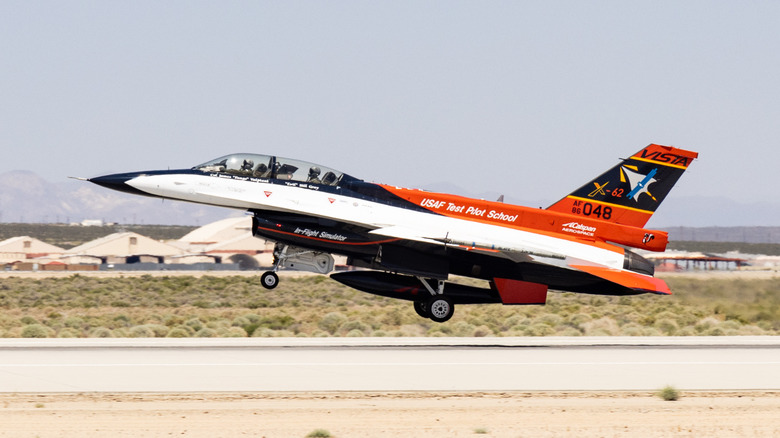A Human Pilot Battled An AI-Controlled F-16 In A Real Dogfight - Here's What Happened
Everyone is working to find how artificial intelligence can give them a leg up in their respective fields, and the U.S. military is no different. From enhancing the capabilities of battle-tested drones to overhauling its IT management and battlefield decision-making processes, the U.S. military is using AI to change its approach to warfare in hopes of staying on the cutting edge of global defense developments. One of the most innovative applications of this technology is in aerial combat, where the Defense Advanced Research Projects Agency (DARPA) has spent the last four years building AI combat applications. One project is its Air Combat Evolution program, which looks to build AI-driven solutions to problems faced during dogfighting. An increasingly realistic solution is the construction of collaborative combat aircraft — unmanned, AI-controlled aircraft that the Air Force hopes will operate alongside piloted fighter jets like autonomous wingmen.
In April 2024, the program experienced a breakthrough when its X-62A Variable In-flight Simulator Aircraft (VISTA) battled an F-16 in a series of dogfights above Edwards Air Force Base in Kern County, California. The program's manager, Lt. Col. Ryan Hefron, told Defense News, "The purpose of the test was to demonstrate we can safely test these AI agents in a safety-critical air combat environment." Agentic AI could provide several benefits to the battlefield, increasing efficiency and data actualization while reducing complicating factors inherent in human pilots. And while DARPA's AI-pilot program is still in development, former Air Force Secretary Frank Kendall stated in 2024 that the U.S. hopes to deploy weapon-equipped uncrewed aircraft by 2030.
Man vs. machine
DARPA's VISTA jet, operated by the U.S. Air Force's Test Pilot School, is an F-16 that has been modified with an autonomous flight program. According to the agency, the fighter jet's AI follows the same basic principles as conventional machine learning applications, in that it analyzes large datasets of historic flight scenarios to determine the best solution in real time. Before scaling up to its first flight tests, the program gained experience by running a series of dogfighting scenarios conducted through a flight simulator. Conducting five of these simulated flight tests against human pilots, VISTA's AI agent scored a perfect record against its human foes, although DARPA admits that agentic pilots weren't beholden to the same safety or ethics requirements as their human counterparts. VISTA took its training to the skies in December 2022, executing increasingly difficult training exercises until it finally faced off against human-piloted F-16s the following September. Before these tests, the Air Force had exclusively used autonomous features for actions with defined rules and expectations, like Auto Ground Collision Avoidance Systems, which prevent fighter jets from crashing.
Over the course of 21 flight tests, culminating in the aforementioned dogfights, the AI-controlled fighter reportedly reached supersonic speeds while conducting several aggressive maneuvers, including vertical maneuvers and nose-to-nose passes. With human pilots on deck to handle malfunctions, VISTA flew in proximity to the F-16, coming within 2,000 feet of the human-piloted aircraft. In one test, machine-and-human-piloted aircraft battled to get into better attack positions. According to the Air Force, the AI's performance was about even with its human counterpart. Beyond traditional performance metrics, DARPA's team learned several critical lessons, including how to adapt and upload updates to its AI software in real time.
A promising future
The U.S. isn't the only air force looking to apply AI to dogfighting. Swedish defense contractor Saab, for instance, announced in June 2025 that it had completed the first test flights of its AI pilot program Centaur on its Gripen E fighter jets, including several sorties engaging with human-piloted fighters. According to Saab, rather than using an experimental aircraft like VISTA, the AI software was loaded directly onto the Gripen E. In Turkey, the country's Scientific Technological Research Council announced that its fifth-generation KAAN fighter jet will incorporate an AI library into its avionics. According to Turkish officials, the land-based portion of the system is already complete. China's AI pilot program, dubbed Red Eye, has made significant strides, with its manufacturers releasing studies showcasing its prowess against human-piloted aircraft in December 2024.
The ACE program goes beyond dogfighting, however. As Col. Hefron put it, ACE is "really about building trust in responsible AI." This is a critical step in the United States Air Force's strategic roadmap, as it has heavily invested in AI tools over the years. In addition to ACE, it has launched its own agentic chatbot, established both an AI Center of Excellence and an AI accelerator, tested battlefield-decision-making programs, and looked to incorporate AI into its IT infrastructure. Despite these advancements, however, Air Force Chief of Staff General David Allvin noted in June 2025 that integrating AI solutions into daily operations had been a "mixed bag." Moving forward, Air Force leaders view the ACE program as critical to establishing institutional trust in the emerging technology.


